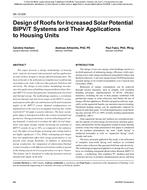
SA-12-028 — Design of Roofs for Increased Solar Potential BIPV/T Systems and their Applications to Housing Units
- Comments Off on SA-12-028 — Design of Roofs for Increased Solar Potential BIPV/T Systems and their Applications to Housing Units
- ASHRAE
Click here to purchase
This paper presents a design methodology of housingunits’ roofs for increased solar potential, and the applicationof some of these designs to energy efficient housing units. Thebasic principle is the utilization of complete near-south facingroof surfaces for solar collectors that generate both heat andelectricity. The design of roof surface morphology incorporatesthe application of building-integrated photovoltaic/thermal(BIPV/T) system that generates simultaneously electricaland thermal energy. The methodology employs a correlationbetween thermal and electrical output of the BIPV/T system,and analysis of the effect of combinations of tilt and orientationangles of the BIPV/T system. Optimal configurations areimplemented in the roof of a rectangular housing unit. Gableroof with 45° tilt angle is used as reference. The basic rectangularshape is redesigned to follow the contour of optimal roofgeometries. Energy performance, in terms of heating and coolingdemands, is analyzed to evaluate the effect of roof shape.Some roof shape designs enable increasing the potential ofBIPV/T systems by up to 30%, as compared to the referenceroof. The effect of roof design on heating and cooling loads isnot highly significant ( less than 5%). While redesigning unit shapesdoes not significantly affect their energy performance, it canprovide some design flexibility. In addition to optimizingenergy production, the integration of photovoltaic/thermalsystems in surfaces with different orientations enables a spreadof the timing of peak electricity generation over up to 3 hours.This feature can be beneficial in reducing mismatch betweendemand and supply of the grid.
Product Details
- Published:
- 2012
- Number of Pages:
- 17
- File Size:
- 1 file , 4.3 MB
- Product Code(s):
- D-SA-12-028
- Note:
- This product is unavailable in Russia, Belarus

